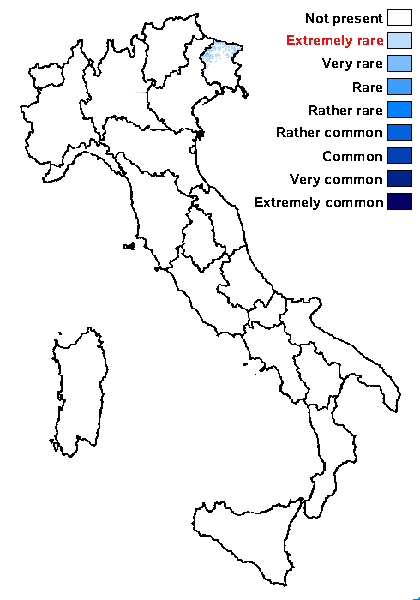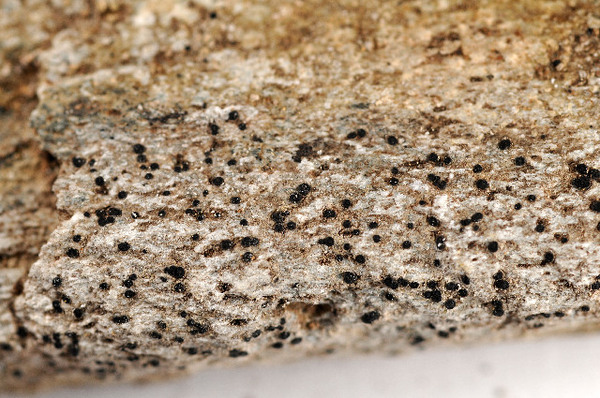Rhizocarpon postumum (Nyl.) Arnold
Flora (Regensburg) 53, 30–31: 478, 1871 (1870).. Basionym: Lecidea postuma Nyl. - Flora (Regensburg), 51: 345, 1868.
Synonyms:
Distribution: N - Frl (Nascimbene & al. 2021).
Description: Thallus crustose, very thin, cracked to areolate, grey to pale brown, rarely delimited by a black prothallus, forming small patches to 1-2 cm across. Areoles up to 0.2 mm wide, flat to slightly convex, smooth. Apothecia lecideine, innate to slightly sessile, 0.3-0.5 mm across, with a black-brown to black, somehow shiny, flat to finally convex, rough disc, and a persistent, thick, often crenulate, black proper margin. Proper exciple of radiating hyphae, the outer cells olive-brown to blackish green, K-; epithecium brown, K-, with crystals soluble in K; hymenium colourless, 80-90 µm high, I+ blue; paraphysoids slender, scarcely swelling at apex, without a strongly delimited pigmented cap; hypothecium brown. Asci 8-spored, clavate, fissitunicate, with a well-developed tholus, lacking an ocular chamber, Rhizocarpon-type. Ascospores weakly submuriform (with 5-7 cells in optical view), hyaline, ellipsoid, 16-22 x 10-13 µm, halonate. Photobiont chlorococcoid. Spot tests: medulla K- or K+ yellow, C-, KC-, P- or P+ yellow. Chemistry: medulla without lichen substances or rarely with low amounts of stictic acid.Note: a species recalling Rh. distinctum in the small-sized apothecia, but medulla not amyloid and with stictic acid, apothecia less than 0.5 mm across. with flat, smooth discs, ascospores small (mostly less than 25 µm long), submuriform; on siliceous rocks, often close to streams and waterfalls; widespread in Europe, but rather rare or not always distinguished, with scattered records from the Alps.
Growth form: Crustose
Substrata: rocks
Photobiont: green algae other than Trentepohlia
Reproductive strategy: mainly sexual
Commonnes-rarity: (info)
Alpine belt: very rare
Subalpine belt: very rare
Oromediterranean belt: absent
Montane belt: extremely rare
Submediterranean belt: absent
Padanian area: absent
Humid submediterranean belt: absent
Humid mediterranean belt: absent
Dry mediterranean belt: absent

Predictive model
Herbarium samples
Growth form: Crustose
Substrata: rocks
Photobiont: green algae other than Trentepohlia
Reproductive strategy: mainly sexual
Commonnes-rarity: (info)
Alpine belt: very rare
Subalpine belt: very rare
Oromediterranean belt: absent
Montane belt: extremely rare
Submediterranean belt: absent
Padanian area: absent
Humid submediterranean belt: absent
Humid mediterranean belt: absent
Dry mediterranean belt: absent

Predictive model
| Herbarium samples |
 Index Fungorum
Index Fungorum
 GBIF
GBIF


